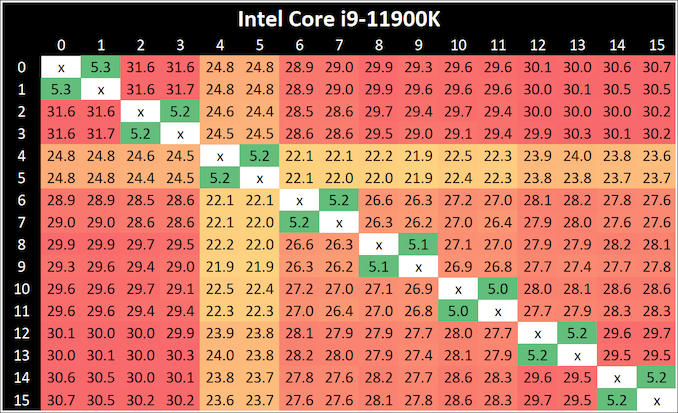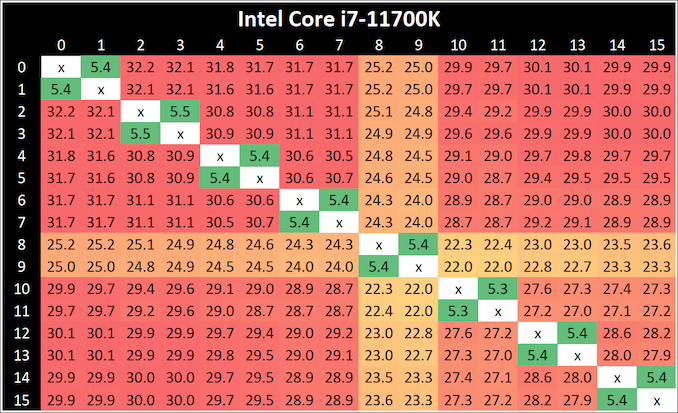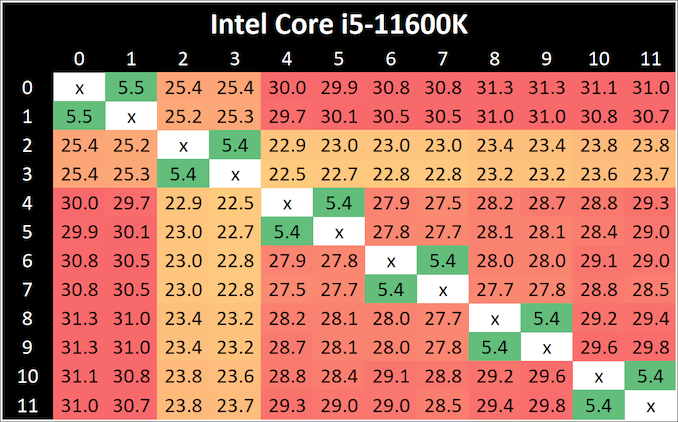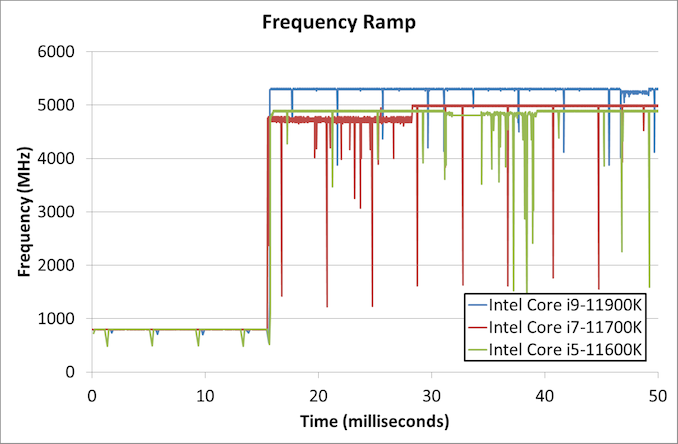Intel Rocket Lake (14nm) Review: Core i9-11900K, Core i7-11700K, and Core i5-11600K
by Dr. Ian Cutress on March 30, 2021 10:03 AM EST- Posted in
- CPUs
- Intel
- LGA1200
- 11th Gen
- Rocket Lake
- Z590
- B560
- Core i9-11900K
CPU Tests: Microbenchmarks
Core-to-Core Latency
As the core count of modern CPUs is growing, we are reaching a time when the time to access each core from a different core is no longer a constant. Even before the advent of heterogeneous SoC designs, processors built on large rings or meshes can have different latencies to access the nearest core compared to the furthest core. This rings true especially in multi-socket server environments.
But modern CPUs, even desktop and consumer CPUs, can have variable access latency to get to another core. For example, in the first generation Threadripper CPUs, we had four chips on the package, each with 8 threads, and each with a different core-to-core latency depending on if it was on-die or off-die. This gets more complex with products like Lakefield, which has two different communication buses depending on which core is talking to which.
If you are a regular reader of AnandTech’s CPU reviews, you will recognize our Core-to-Core latency test. It’s a great way to show exactly how groups of cores are laid out on the silicon. This is a custom in-house test built by Andrei, and we know there are competing tests out there, but we feel ours is the most accurate to how quick an access between two cores can happen.
All three CPUs exhibit the same behaviour - one core seems to be given high priority, while the rest are not.
Frequency Ramping
Both AMD and Intel over the past few years have introduced features to their processors that speed up the time from when a CPU moves from idle into a high powered state. The effect of this means that users can get peak performance quicker, but the biggest knock-on effect for this is with battery life in mobile devices, especially if a system can turbo up quick and turbo down quick, ensuring that it stays in the lowest and most efficient power state for as long as possible.
Intel’s technology is called SpeedShift, although SpeedShift was not enabled until Skylake.
One of the issues though with this technology is that sometimes the adjustments in frequency can be so fast, software cannot detect them. If the frequency is changing on the order of microseconds, but your software is only probing frequency in milliseconds (or seconds), then quick changes will be missed. Not only that, as an observer probing the frequency, you could be affecting the actual turbo performance. When the CPU is changing frequency, it essentially has to pause all compute while it aligns the frequency rate of the whole core.
We wrote an extensive review analysis piece on this, called ‘Reaching for Turbo: Aligning Perception with AMD’s Frequency Metrics’, due to an issue where users were not observing the peak turbo speeds for AMD’s processors.
We got around the issue by making the frequency probing the workload causing the turbo. The software is able to detect frequency adjustments on a microsecond scale, so we can see how well a system can get to those boost frequencies. Our Frequency Ramp tool has already been in use in a number of reviews.
From an idle frequency of 800 MHz, It takes ~16 ms for Intel to boost to the top frequency for both the i9 and the i5. The i7 was most of the way there, but took an addition 10 ms or so.














279 Comments
View All Comments
schujj07 - Tuesday, March 30, 2021 - link
It would have the exact same power draw under AVX512 as AVX2. The 142ishW draw is socket maximum. The only way to increase power draw to the CPU socket is to change sockets.maroon1 - Tuesday, March 30, 2021 - link
Only way to get same power draw with AVX-512 is to lower clock speed a lot which effects performanceschujj07 - Tuesday, March 30, 2021 - link
That doesn't change the fact that Ryzen is socket limited for power draw. While lowering clocks affects performance, AVX512 could still be faster at same power draw on Ryzen.whatthe123 - Wednesday, March 31, 2021 - link
Zen 3 isn't socket limited. All you have to do is enable PBO and you can manually set the package limit to whatever you want. I can set my 5900x power limit to whatever I want, though the boost gains aren't worth the extra heat.Qasar - Wednesday, March 31, 2021 - link
um yes it is, 142 watts is as much as it can use : " Notably, AMD's decision to stick with the AM4 socket still constrains its maximum power consumption to 142W, which means that it could not increase power consumption for the new flagship models. "from here : https://www.tomshardware.com/reviews/amd-ryzen-5-5...
TheinsanegamerN - Wednesday, March 31, 2021 - link
Hrm um yeah, no, you're wrong.Gamers nexus measured over 190 watts on a 2700x, which is socket AM4:
https://www.gamersnexus.net/hwreviews/3287-amd-r7-...
29a - Wednesday, March 31, 2021 - link
Thats overclocked, non overclocked wattage is 142W. Nice try.SaturnusDK - Wednesday, March 31, 2021 - link
AM4 and whatever intel calls the current iteration of the 1150/1151/1200 socket has the exact same technical power limit. Well, almost. It's 142W vs 144W. Usually written as 125W (+15%).You can safely draw double that wattage through the socket though on both platforms. The interesting thing is that the 11th gen apparently throws all sense and caution to the wind in an attempt to stay competitive that they're willing to accept an obscene RMA percentage on the sales.
whatthe123 - Wednesday, March 31, 2021 - link
Toms literally contradicts itself in that article by running 5900x with PBO at 172 watt. Socket is not the limit, the bios imposed PPT is the limit.Oxford Guy - Wednesday, March 31, 2021 - link
What cooler was used? It bet it was stronger than the Noctua used here for AMD.